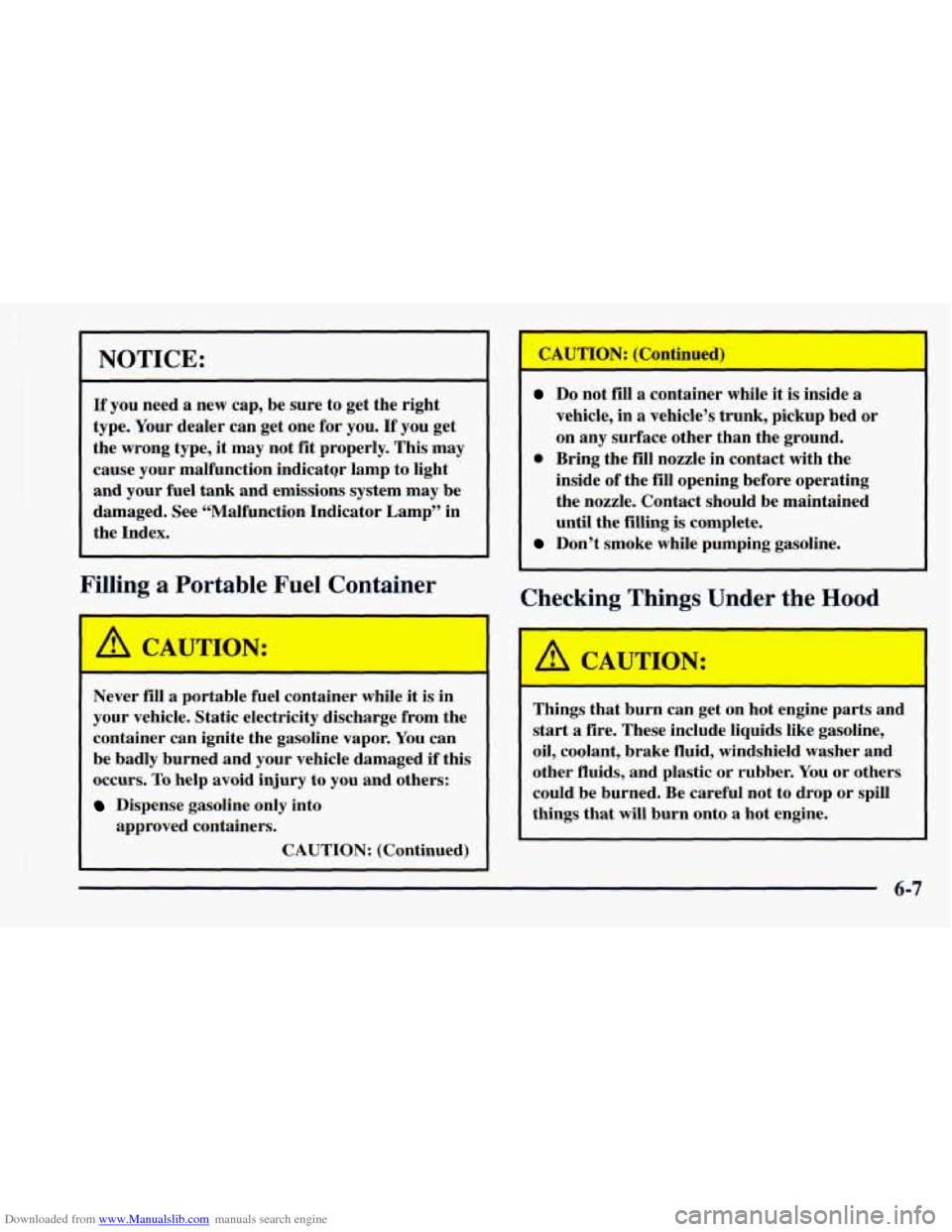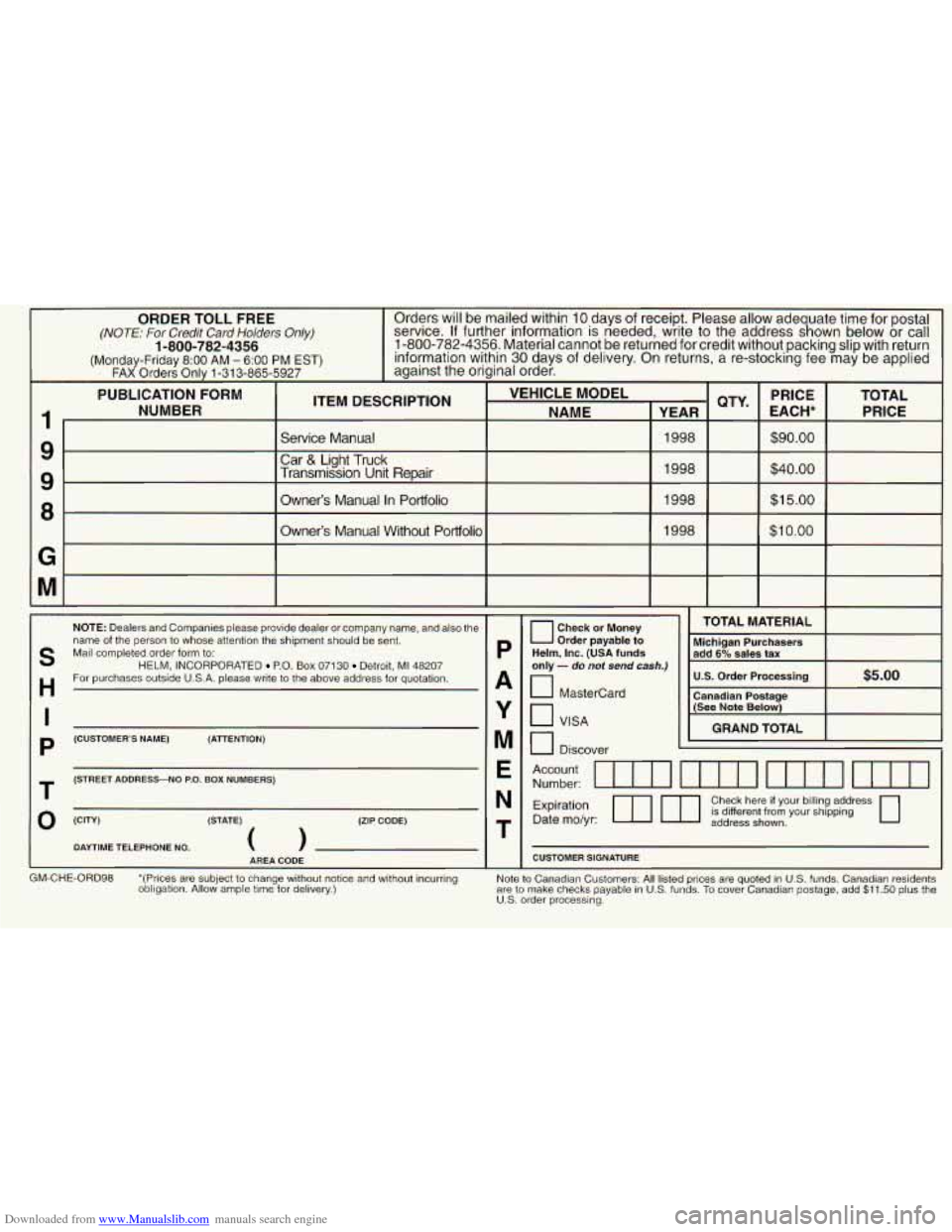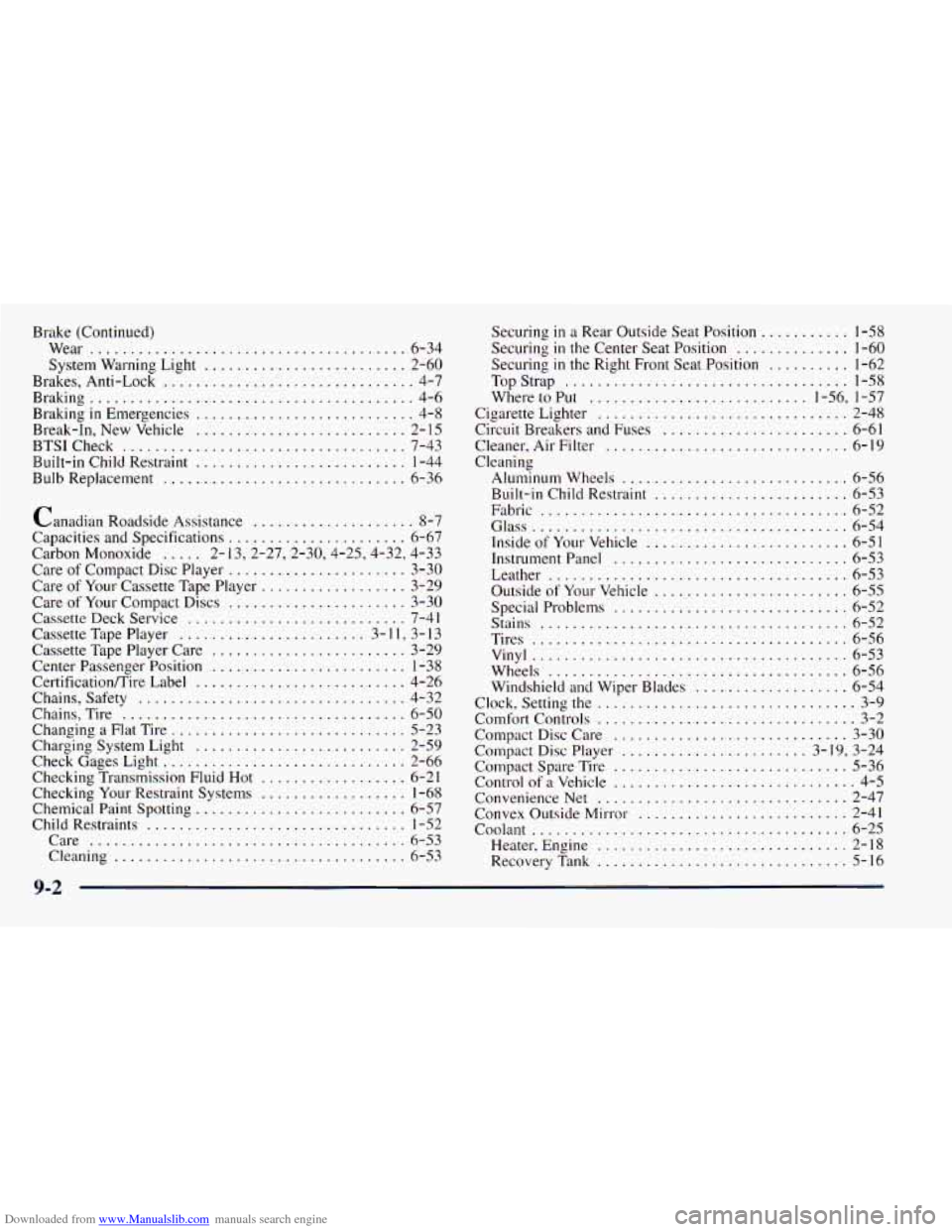1998 CHEVROLET ASTRO check engine light
[x] Cancel search: check engine lightPage 203 of 414

Downloaded from www.Manualslib.com manuals search engine The most important advice on freeway driving is: Keep
up with traffic and keep
to the right. Drive at the same
speed most of the other drivers are driving. Too-fast or
too-slow driving breaks a smooth traffic flow. Treat the
left lane
on a freeway as a passing lane.
At the entrance, there is usually a ramp that leads to the
freeway.
If you have a clear view of the freeway as you
drive along the entrance ramp, you should begin
to
check traffic. Try to determine where you expect to
blend with the flow. Try to merge into the gap at close to
the prevailing speed. Switch
on your turn signal, check
your mirrors and glance over your shoulder as often as
necessary. Try to blend smoothly with the traffic flow.
Once you are on the freeway, adjust your speed to the
posted limit or to the prevailing rate if it’s slower. Stay
in the right lane unless
you want to pass.
Before changing lanes, check your mirrors. Then use
your turn signal.
Just before
you leave the lane, glance quickly over your
shoulder to make sure there isn’t another vehicle in your
“blind” spot.
Once
you are moving on the freeway, make certain you
allow a reasonable following distance. Expect to move
slightly slower
at night. When
you want
to leave the freeway, move to the proper
lane well in advance. If you miss your exit, do not,
under any circumstances, stop and back up. Drive
on to
the next exit.
The exit ramp can be curved, sometimes quite sharply.
The exit speed is usually posted.
Reduce your speed according
to your speedometer, not
to your sense of motion. After driving for any distance
at higher speeds,
you may tend to think you are going
slower than
you actually are.
Before Leaving on a Long Trip
Make sure you’re ready. Try to be well rested. If you
must start when you’re not fresh
-- such as after a day’s
work
-- don’t plan to make too many miles that first part
of the journey. Wear comfortable clothing and shoes
you
can easily drive in.
Is your vehicle ready for a long trip? If you keep it
serviced and maintained, it’s ready to go. If it needs
service, have it done before starting out. Of course,
you’ll find experienced and able service experts in GM
dealerships all across
North America. They’ll be ready
and willing to help
if you need it.
Page 209 of 414

Downloaded from www.Manualslib.com manuals search engine Tie a red cloth to your vehicle to alert police that
you’ve been stopped by the snow.
Put on extra clothing or wrap a blanket around you.
If you have no blankets or extra clothing, make body
insulators from newspapers, burlap bags, rags, floor
mats
-- anything you can wrap around yourself or
tuck under your clothing
to keep warm.
Sr Y can trap exha. ler your vehicle.
~ This can cause deadly 60 (carbon monoxide) gas
to get inside. CO could overcome you and kill
you.
You can’t see it or smell it, so you might not
know
it is in your vehicle. Clear away snow from
around the base of your vehicle, especially any
~ that is blocking your exhaust pipe. And check
around again from time to time to be sure snow
doesn’t collect there.
Open a window just
a little on the side of the
vehicle that’s
away from the wind. This will help
~ keep CO out.
Run your engine only as long as you must. This saves
fuel. When you run
the engine, make it go a little faster
than just idle. That is, push the accelerator slightly. This
uses less fuel for the heat that you get and it keeps the
battery charged. You will need a well-charged battery
to
restart the vehicle, and possibly for signaling later on
with your headlamps. Let
the heater run for a while.
You can run the engine to keep warm, but be careful.
4-25
Page 269 of 414

Downloaded from www.Manualslib.com manuals search engine I
NOTICE:
If you need a new cap, be sure to get the right
type. Your dealer can get one for you.
If you get
the wrong type, it may not fit properly. This may cause your malfunction indicator lamp to light and your fuel tank and emissions system may be
damaged. See “Malfunction Indicator Lamp” in
the Index.
Filling a Portable Fuel Container
A CAUTION:
Never fill a portable fuel container while it is in
your vehicle. Static electricity discharge from the
container can ignite the gasoline vapor.
You can
be badly burned and your vehicle damaged if this
occurs.
To help avoid injury to you and others:
Dispense gasoline only into
approved containers.
CAUTION: (Continued)
I
Do not fill a container whilc : is inside a
vehicle, in a vehicle’s trunk, pickup bed or
on any surface other than the ground.
inside of the fill opening before operating
the nozzle. Contact should be maintained
until the filling
is complete.
0 Bring the fill nozzle in contact with the
Don’t smoke while pumping gasoline.
Checking Things Under the Hood
A CAUTION: I
Things that burn can get on hot engine parts and
start a fire. These include liquids like gasoline,
oil, coolant, brake fluid, windshield washer and
other fluids, and plastic
or rubber. You or others
could be burned. Be careful not to drop or spill
things that will burn onto a hot engine.
6-7
Page 287 of 414

Downloaded from www.Manualslib.com manuals search engine Rear Axle
When to Check and Change Lubricant
Refer to the Maintenance Schedule to determine how
often
to check the lubricant and when to change it. See
“Scheduled Maintenance Services” in the Index.
How to Check Lubricant
If the level is below the bottom of the filler plug hole,
you’ll need to add some lubricant. Add enough lubricant
to raise the level to the bottom
of the filler plug hole.
What to Use
Refer to the Maintenance Schedule to determine what
kind of lubricant
to use. See “Recommended Fluids and
Lubricants” in the Index.
Engine Coolant
The cooling s stem in your vehicle is filled with
DEX-COOL engine coolant. This coolant
is designed
to remain in your vehicle for
5 years or 150,000 miles
(240
000 km) whichever occurs first, if you add only
DEX-COOL’ extended life coolant.
The following explains your cooling system and how to
add coolant when it is low. If you have a problem with
engine overheating,
see “Engine Overheating” in
the Index.
A 50/50 mixture of water and DEX-COOL@
coolant will:
Give freezing protection down to -34°F (-37°C).
0 Give boiling protection up to 265 “F ( 129°C).
0 Protect against rust and corrosion.
Help keep the proper engine temperature.
Let the warning lights and gages work as
B
they should.
6-25
Page 376 of 414

Downloaded from www.Manualslib.com manuals search engine At Least Twice a Year Automatic lkansmission Check
Restraint System Check
Make sure the safety belt reminder light and all your
belts, buckles, latch plates, retractors and anchorages are
working properly. If your vehicle has a built-in child
restraint, also periodically make sure the harness straps,
latch plates, buckle, clip, retractors and anchorages are
working properly. Look for any other loose or damaged
safety belt and built-in child restraint system parts. If
you see anything that might keep a safety belt or built-in
child restraint system from doing its
job, have it
repaired. Have any torn or frayed safety belts or harness
straps replaced.
Also look for
any opened or broken air bag coverings,
and have them repaired or replaced. (The air bag system
does
not need regular maintenance.)
Wiper Blade Check
Inspect wiper blades for wear or cracking. Replace blade
inserts that appear worn or damaged or that streak or
miss areas
of the windshield. Also see “Wiper Blades,
Cleaning” in the Index. Check the transmission fluid
level; add if needed.
See
“Automatic Transmission’’ in the Index. A fluid loss
may indicate a problem. Check the system and repair
if needed.
At Least Once a Year
Key Lock Cylinders Service
Lubricate the key lock cylinders with the lubricant
specified in Part
D.
Body Lubrication Service
Lubricate all body door hinges, the body hood, fuel
door and rear compartment hinges, latches and locks
including interior glove box and console doors, and any
moving seat hardware. Lubricate the hood safety lever
pivot and prop rod pivot. Part
D tells you what to use.
More frequent lubrication may be required when
exposed to a corrosive environment.
7-42
Page 397 of 414

Downloaded from www.Manualslib.com manuals search engine ORDER TOLL FREE Orders will be mailed within 10 days of receipt. Please allow ade uate time for postal
(NOTE: For Credit Card Holders Only) service. If further information is needed, write to the address s gn own below or call
(Monday-Friday 8:OO AM - 6:OO PM EST) information within 30 days of delivery. On returns, a re-stocking fee may be applied 1-800-782-4356 1-800-782-4356. Material cannot be returned for credit without packing slip with return
FAX Orders Only 1-31 3-865-5927 against the original order.
PUBLICATION FORM ITEM DESCRIPTION VEHICLE MODEL PRICE
EACH* TOTAL
NUMBER NAME YEAR PRICE
Service Manual 1998 $90.00
Car
& Light Truck
Transmission Unit Repair 1998
$40.00
Owner’s Manual In Portfolio 1998 $1
5.00
Owner’s Manual Without Portfolio
1998 $1 0.00
QTYm
1
9
9
8
G
S
H
I
P
T
0
NOTE: Dealers and Companies please provide dealer or company name, and also the
name of the person to whose attention the shipment should be sent.
Mail completed order form to:
For purchases outside U.S.A. please write
to the above address for quotation.
HELM, INCORPORATED P.O. Box 07130 Detroit, MI 48207
(CUSTOMER’S NAME)
(ATTENTION)
(STREET ADDRESS-NO P.O.
BOX NUMBERS)
(CITY) (STATE) (ZIP CODE)
DAYTIME TELEPHONE NO.
0
AREA CODE
GM-CHE-ORD98 *(Prices are subject to change without notice and without incurring
obligation. Allow ample time for delivery.)
L
-
P
A
Y
M
E
N
T
TOTAL MATERIAL
Order payable to Michigan Purchasers
Helm, Inc. (USA funds add 6% sales tax
only - do not send cash.) U.S. Order Processing
Mastercard
c] VISA
0 Discover
Account Number:
UIn tun UIn uIn
Expiration m ml Check here if your billing address
Date mo/yr: is different from your shipping
address shown.
CUSTOMER SIGNATURE L
are to make checks payable in US. funds. To cover Canadian postage, add $1 1.50 plus the
Note to Canadian Customers: All listed prices are quoted
in U.S. funds. Canadian residents
U.S. order processing.
Page 399 of 414

Downloaded from www.Manualslib.com manuals search engine Section 9 Index
Accessory Power Outlet ......................... 2-50
Add-on Equipment ............................. 4-28
AirBag
....................................... 1-26
Adding Equipment
............................ 1-32
How Does
it Restrain .......................... 1-30
How
it Works ................................ 1-28
Location
.................................... 1-28
Readiness Light
......................... 1.27. 2.58
Servicing
................................... 1-31
What Makes
it Inflate .......................... 1-29
What Will You See After
it Inflates ............... 1-30
When Should it Inflate ......................... I -29
AirCleanerFilter
............................... 6-19
Air Conditioning
................................ 3-5
Air Conditioning Refrigerants
..................... 6-68
Alignment and Balance. Tire
...................... 6-48
All-Wheel Drive
.......................... 2.28. 6.23
Aluminum Wheels. Cleaning ...................... 6-56
Antenna. Fixed Mast
............................ 3-30
Antifreeze
..................................... 6-25
Anti-Lock Brake System Warning Light
................ 2.61. 4.7
Brakes
...................................... 4-7
Anti.Theft. Radio
.............................. 3-26
Appearance Care
............................... 6-5 1
Appearance Care Materials ....................... 6-58
Arbitration Program .............................. 8-9
Ashtrays
...................................... 2-48 Audio Equipment.
Adding
...................... 3-28
Audio Systems
........................... ... 3-9
Automatic Transmission Check
........................... 7-42
Transmission Operation
........................ 2-19
Transmission Fluid
............................ 6-20
Front
......... ... ................... 6-24
Locking Rear
.............................. 2-28
Rear
...... ............................ 6-25
Axle
Battery
...................................... 6-35
Jump Starting ................................. 5-3
Replacement. Remote Keyless Entry
............... 2-9
Warnings .................................... 5-3
BBB Auto Line ................................. 8-9
Better Business Bureau Mediation
................... 8-9
Blizzard ...................................... 4-24
Brake Adjustment
................ .............. 6-35
Fluid
....................................... 6-31
Master Cylinder
.............................. 6-31
Parking
..................................... 2-22
PedalTravel
................................. 6-35
Replacing System Parts
........................ 6-35
Trailer
...................................... 4-32
Transmission Shift Interlock Check
............... 7-43
9-1
Page 400 of 414

Downloaded from www.Manualslib.com manuals search engine Brake (Continued)
Wear
..................................
Brakes. Anti-Lock .........................
Braking ..................................
Braking in Emergencies .....................
Break-In. New Vehicle .....................
BTSI Check ..............................
Built-in Child Restraint .....................
Bulb Replacement ........................
System Warning Light ....................
Canadian Roadside Assistance ..............
Capacities and Specifications .................
Carbon Monoxide ..... 2- 13.2.27.2.30.4.25.
Care
of Compact Disc Player .................
Care of Your Cassette Tape Player .............
Care of Your Compact Discs .................
Cassette Deck Service ......................
Cassette Tape Player .......................
Cassette Tape Player Care ...................
Center Passenger Position ...................
Certification/Tire Label .....................
Chains. Safety ............................
Chains. Tire ..............................
Changing a Flat Tire ........................
Charging System Light .....................
Check Gages Light .........................
Checking Transmission Fluid Hot .............
Checking Your Restraint Systems .............
Chemical Paint Spotting .....................
Child Restraints ...........................
Care ..................................
Cleaning ...............................
9-2
..... 6-34
..... 2-60
...... 4-7
...... 4-6
...... 4-8
..... 2-15
..... 7-43
..... 1-44
.... 6-36
...... 8-7
..... 6-67
4.32. 4.33
..... 3-30
..... 3-29
..... 3-30
..... 7-41
3-1 1. 3.13
..... 3-29
..... 1-38
..... 4-26
..... 4-32
..... 6-50
..... 5-23
..... 2-59
..... 2-66
..... 6-21
..... 1-68
..... 6-57
..... 1-52
..... 6-53
..... 6-53 Securing
in a Rear
Outside Seat Position ........... 1-58
Securing in the Center Seat Position .............. 1-60
Securing
in the Right Front Seat Position .......... 1-62
TopStrap
................................... 1-58
Where to Put ........................... 1-56. 1-57
Cigarette Lighter ............................... 2-48
Circuit Breakers and Fuses
....................... 6-61
Cleaner.
Air Filter .............................. 6-19
Cleaning
Aluminum Wheels ............................ 6-56
Built-in Child Restraint ........................ 6-53
Fabric
...................................... 6-52
Glass ....................................... 6-54
Inside
of Your Vehicle ......................... 6-51
Instrument Panel
............................. 6-53
Leather
..................................... 6-53
Outside of Your Vehicle
........................ 6-55
Stains ...................................... 6-52
Tires
....................................... 6-56
Wheels
..................................... 6-56
Windshield and Wiper Blades
................... 6-54
Clock. Setting the
................................ 3-9
Comfort Controls
................................ 3-2
Compact Disc Care
............................. 3-30
Compact Disc Player
....................... 3-19. 3-24
Compact Spare Tire
............................. 5-36
Control
of a Vehicle .............................. 4-5
ConvenienceNet
............................... 2-47
Convex Outside Mirror
.......................... 2-41
Coolant
....................................... 6-25
Heater. Engine
............................... 2-18
Recovery Tank ............................... 5-16
Special Problems
................. ....... 6-52
Vinyl ....................................... 6-53